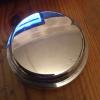Think about this from our point of view for a minute. The evidence you have provided (ignoring the evidence that this tap actually exists for a moment which is a seperate issue) comes from a very old manual. This is why I asked you whether the manual in question describes the coil spring clutch or the diaphragm spring clutch. What date is the manual? You may not be aware that cranks, primary gears and flywheel bolts were all changed in 1963. The flywheel bolt from a 1959 - 62 car is not compatible with the crank from a later car and I've never known why but it may be due to the thread. Officially the only change was the primary gear design though. My earliest BMC manual is dated 1969 and doesn't describe this thread (I have an Autobook from 1968 that lists the coil spring clutch but it doesn't describe the thread either), giving me the impression that after the crank change the thread became a more recognised standard. Especially considering that between the date of the original design of the Mini and the redesign of the primary gear the Whitworth thread was dropped by British Standards. Not knowing the date of your blue book makes this more than a little uncertain still but its a working theory. Bearing in mind that several well known and respected engine builders use a certain thread makes it a little more believable than a very old manual published about the time that this thread may have been redesigned.
The real oddity is that one or other of these taps must be wrong. You haven't found a problem using your Whitworth tap and others have had no problem with a UNS tap. Despite the fact that you seem to be assuming that everyone is shaving a lot of swarf off their threads and simply not noticing I tend to assume that isn't the case for either you or anyone else. The difference is not simply a 5 degree change in cut angle, because the thread pitch of each is the same at 16 TPI the change in angle will make the thread depth very different. Since the major diameter is the same at 5/8" the extra depth of the thread will mean the Whitworth tap isn't actually touching anything other than the peak of the thread inside the crank if the thread is UNS. It wouldn't be capable of cutting anything. If it were the other way around however there would be a real problem with lots of material being removed. The problem would be reversed when dealing with the male thread on the bolt. The simple way to prove this is with a thread gauge and a selection of cranks and flywheel bolts from either side of 1963 but personally I don't have all that to hand. Or with a die of one thread or the other being run down a flywheel bolt but I doubt anybody has a die like that and with a split die that wouldn't really be proof anyway.
This is what you call a debate. That is where people have differing opinions and use structured arguments to back them up hoping to find a resolution. No evidence is ever impirical, especially when it's getting on towards 50 years old. I don't believe anyone here sets themselves up as an expert, we all learn from one another. Some know more than others but we all learn. Frankly the 'in-line engine debate' was nothing more than farcical. If you can't accept that words can have more than one meaning, especially when dealing with a language used by so many different nations you are in for a lot of dissapointment in life.
Edited by Dan, 28 March 2009 - 08:34 PM.
















